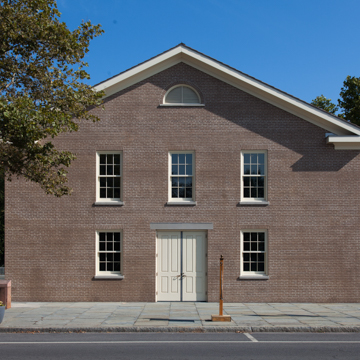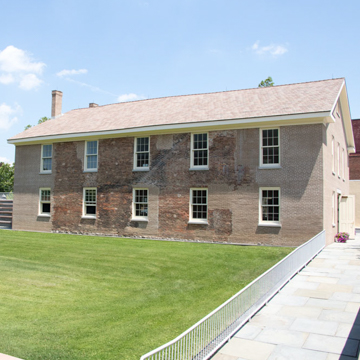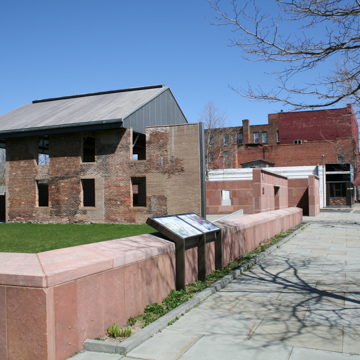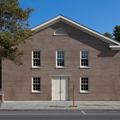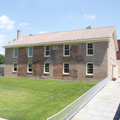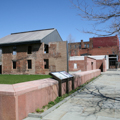Wesleyan Chapel was the site of the first Women’s Rights Convention on July 19–20, 1848, a transformative event that galvanized the women’s suffrage movement. Located in Seneca Falls, a small town in upstate New York, the Wesleyan Methodist Chapel was built in 1843 as the home to a newly formed and radical religion. That year in Utica, the Wesleyan Methodist Connection had split off from the Methodist Episcopal Church, primarily over its commitment to the abolition of slavery and other liberal reforms.
The two-story brick building with a gabled roof is a simple structure that belies the momentous event that occurred in 1848, when the organizers presented their Declaration of Sentiments. The convention was planned by Jane Hunt, Lucretia Mott, Elizabeth Cady Stanton, Mary Ann M’Clintock, and Martha Coffin Wright in Hunt’s home in nearby Waterloo, New York. Seneca Falls, however, was where the event itself would take place. For one, Seneca Falls was located in a region of New York that was rife with religious and social experiments. The organizers knew that Wesleyan Chapel was a haven for religious freedom and free speech, and its congregation held a policy of accommodating requests from any group to use its space for meetings. These groups included white abolitionists, free African Americans, temperance advocates, groups from other faiths, and champions for women’s rights. The town was also recently linked to modern transportation infrastructure. By 1848 train service connected Seneca Falls to Rochester, Waterloo, and Geneva to the west, and Auburn and Syracuse to the east. Its waterfalls powered a growing number of factories and mills, whose goods could be shipped using the nearby Erie Canal. By 1848 a few personal trips and some well-placed advertisements in local newspapers made it easy for visitors, including Fredrick Douglass, to attend the event on short notice.
Little is known about the original chapel interior, except that it had rows of pews, a gallery on three sides, and measured 44 by 64 feet. Over 300 people crowded into the building to attend the two-day event. When the organizers arrived, they found the chapel doors locked and had to lift a boy through an open window to enter the building and unbar the door as crowds began to arrive by carriage and on foot. The first day’s events were meant to be for women only, but since so many men had also arrived, the organizers quickly reversed their decision. After a day of speeches, Stanton read the Declaration of Sentiments, which was adopted the next day and signed by 100 of the attendees, 68 women and 32 men.
While the women’s rights movement continued to thrive after the convention, the Seneca Fall’s Wesleyan congregation did not. In 1871 the congregation disbanded and sold the building. The former chapel was significantly altered to accommodate its changing functions over the years: various stores, an opera house, a theater, car dealerships, and a laundromat. At some point, the building was fitted for electricity and plumbing, and the front and rear walls were removed to enlarge the structure. While a plaque on the street indicated the site’s historical import, the building itself was all but erased.
In 1985 the National Park Service purchased the property to become part of the Women’s Rights National Historical Park, which was established in 1980 and includes the homes of Stanton, Hunt, and M’Clintock. From 1987 until 1993 the site was reimagined and transformed into a monument. All non-original elements of the chapel were removed and it stood as a ruin-in-wait for well over a decade. Between 2008 and 2010 it was transformed yet again. New brick walls and a roof both protected the original structure and created a usable interior. Although the dimensions and proportions are the same as the original building, the new brick is of a different color, which clearly highlights the reconstructed areas.
References
Brown, Sharon A. Wesleyan Chapel. Historic Structure Report, April 1987. U.S. Department of the Interior, National Park Service, Washington, D.C.
McMillen, Sally G. Seneca Falls and the Origins of the Women’s Rights Movement. New York: Oxford University Press, 2008..
Miller, Page Putnam. Landmarks of American Women’s History. New York: Oxford University Press, 2003.
“Wesleyan Chapel Rehabilitation Project.” National Parks Service. Accessed February 25, 2022. http://www.nps.gov/wori/learn/historyculture/wesleyan-chapel-rehabilitat....














